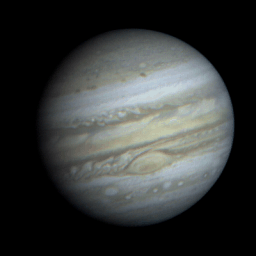
Jupiter
Jupiter is the largest planet in the solar system and is the
first of the four Jovian (outer) planets, all of which are
classified as gas-giants because they appear to have no solid
surface. Because it is so big and bright in the night sky, the
Romans named it after the king of the gods (1). Jupiter is like a
star in many ways. It is made primarily of hydrogen and helium
gasses, and its temperature is cold at the cloud tops but rises
significantly beneath the upper cloud layers (1). Scientists
believe that if Jupiter had grown larger during formation,
gravitational forces might have caused nuclear fusion to occur
and form a star (1).
The clouds on Jupiter are very interesting. They appear as bands,
made mostly of helium and hydrogen, although some methane and
ammonia exist (1). The clouds are very active. Huge storms swirl
around them, and the bands are twisted and turned by strong winds
(1). The Great Red Spot, which is about three times the size of
Earth, is probably a hurricane like storm (1). If it is in fact a
storm, it is the longest lasting storm ever observed in the solar
system (1). Jupiter probably has a small, solid core at its
center. As the clouds get closer to the center of the core, they
become thicker and denser. As the density increases, the clouds
may turn into a giant ocean of liquid hydrogen (1). Because of
Jupiter’s thick cloud cover, the atmospheric pressure is
enormous (up to 100x the surface pressure of Earth) (3). Because
the pressure near the center is so great, the liquid hydrogen
ocean changes into a form of liquid hydrogen that acts like a
metal (1). This liquid metallic core may surround a rocky core
about the size of Earth and is the cause of Jupiter’s huge
magnetic field, the magnetosphere (1). The magnetosphere
stretches for millions of kilometers out into space, and is the
largest single structure in the solar system (1). Other
interesting facts about Jupiter include that it gives off more
heat than it receives from the Sun, it has a thin ring revolving
around it, and some photos revealed huge bolts of lightning and
mysterious sheets of shimmering lights in the sky (1). Jupiter is
778 million km from the sun, has a diameter of 142,700 km, has
11.86 Earth years in a year, and has approximately ten hours in a
day.
Because it has sixteen moons and several rings, Jupiter is
sometimes considered to be a "mini-solar system." The
four largest moons, Io, Europa, Ganymede, and Callisto, were
first discovered by Galileo Galilei in 1610 and were collectively
called the Galilean satellites. (3). Their discovery proved
Galileo’s theory that the Earth was not the center of the
universe because the moons were orbiting Jupiter and not Earth
(2). The Galilean satellites are very unique and have many
interesting qualities.
